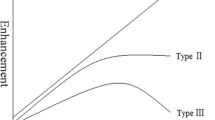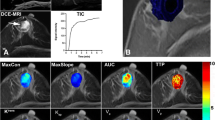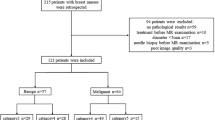Abstract
Background
To propose a semi-automatic method for distinguishing invasive ductal carcinomas from benign lesions on breast dynamic contrast-enhanced magnetic resonance imaging (DCE-MRI).
Methods
142 cases were included. In the conventional method, the region of interest for a breast lesion was drawn manually and the corresponding mean time–signal intensity curve (TIC) was qualitatively categorized. Only one quantitative parameter was obtained: the maximum slope of increase (MSI). By contrast, the proposed method extracted the suspicious breast lesion semi-automatically. Besides MSI, more quantitative parameters reflecting perfusion information were derived from the mean TIC and lesion region, including the signal intensity slope (SIslope), initial percentage of enhancement, percentage of peak enhancement, early signal enhancement ratio, and second enhancement percentage. The mean TIC was categorized quantitatively according to the value of SIslope. Regression models were established. The diagnostic performance differed between the new and conventional methods according to the Wilcoxon rank-sum test and receiver operating characteristic analysis.
Results
According to the TIC categorization results, the accuracies of the traditional and the new method were 59.16% and 76.05%, respectively (P < 0.05). The accuracy was 63.35% for MSI, which was derived from the manual method. For the semi-automatic method, the accuracies were 81.0% and 78.9% for the lesion region and the corresponding mean TIC regression models, respectively.
Conclusions
The results demonstrate that our proposed semi-automatic method is beneficial for discriminating breast IDCs and benign lesions based on DCE-MRI, and this method should be considered as a supplementary tool for subjective diagnosis by clinical radiologists.





Similar content being viewed by others
References
Jemal A, Bray F, Center MM et al (2011) Global cancer statistics. CA Cancer J Clin 61(2):69–90
Mayrhofer RM, Ng HP, Putti TC et al (2013) Magnetic resonance in the detection of breast cancers of different histological types. Magn Reson Insights 6(6):33–49
Weinstein SP, Localio AR, Conant EF et al (2009) Multimodality screening of high-risk women: a prospective cohort study. J Clin Oncol 27(36):6124–6128
Lehman CD, Isaacs C, Schnall MD et al (2007) Cancer yield of mammography, MR, and US in high-risk women: prospective multi-institution breast cancer screening study. Radiology 244(2):381–388
Kumar A, Srivastava V, Singh S et al (2010) Color Doppler ultrasonography for treatment response prediction and evaluation in breast cancer. Future Oncol 6(8):1265–1278
Karellas A, Vedantham S (2008) Breast cancer imaging: a perspective for the next decade. Med Phys 35(11):4878–4897
Brennan M, Spillane A, Houssami N (2009) The role of breast MRI in clinical practice. Aust Fam Physician 38(7):513–519
Kuhl CK (2007) Breast MR imaging at 3T. Magn Reson Imaging Clin N Am 15(3):315–320
Kim JY, Kim SH, Kim YJ et al (2015) Enhancement parameters on dynamic contrast enhanced breast MRI: do they correlate with prognostic factors and subtypes of breast cancers? Magn Reson Imaging 33(1):72–80
Li X, Arlinghaus LR, Ayers GD et al (2014) DCE-MRI analysis methods for predicting the response of breast cancer to neoadjuvant chemotherapy: pilot study findings. Magn Reson Med 71(4):1592–1602
Jansen SA, Lin VC, Giger ML et al (2011) Normal parenchymal enhancement patterns in women undergoing MR screening of the breast. Eur Radiol 21(7):1374–1382
Abramson RG, Li X, Hoyt TL et al (2013) Early assessment of breast cancer response to neoadjuvant chemotherapy by semi-quantitative analysis of high-temporal resolution DCE-MRI: preliminary results. Magn Reson Imaging 31(9):1457–1464
Platel B, Mus R, Welte T et al (2014) Automated characterization of breast lesions imaged with an ultrafast DCE-MR protocol. IEEE Trans Med Imaging 33(2):225–232
Otsu N (1979) A threshold selection method from gray-level histograms. IEEE T Syst Man CY S 9(1):62–66
Kuhl CK, Mielcareck P, Klaschik S et al (1999) Dynamic breast MR imaging: are signal intensity time course data useful for differential diagnosis of enhancing lesions? Radiology 211(1):101–110
Montemurro F, Martincich L, Sarotto I et al (2007) Relationship between DCE-MRI morphological and functional features and histopathological characteristics of breast cancer. Eur Radiol 17(6):1490–1497
Tozaki M (2013) BI-RADS-MRI terminology and evaluation of intraductal carcinoma and ductal carcinoma in situ. Breast Cancer 20(1):13–20
Morris EA (2010) Diagnostic breast MR imaging: current status and future directions. Magn Reson Imaging Clin N Am 18(1):57–74
Lehman CD, Gatsonis C, Kuhl CK et al (2007) MRI evaluation of the contralateral breast in women with recently diagnosed breast cancer. N Engl J Med 356(13):1295–1303
Saslow D, Boetes C, Burke W et al (2007) American Cancer Society guidelines for breast screening with MRI as an adjunct to mammography. CA Cancer J Clin 57(2):75–89
Sardanelli F, Boetes C, Borisch B et al (2010) Magnetic resonance imaging of the breast: recommendations from the EUSOMA working group. Eur J Cancer 46(8):1296–1316
Yabuuchi H, Matsuo Y, Okafuji T et al (2008) Enhanced mass on contrast-enhanced breast MR imaging: Lesion characterization using combination of dynamic contrast-enhanced and diffusion-weighted MR images. J Magn Reson Imaging 28(5):1157–1165
Pinker-Domenig K, Bogner W, Gruber S et al (2012) High resolution MRI of the breast at 3 T: which BI-RADSA (R) descriptors are most strongly associated with the diagnosis of breast cancer? Eur Radiol 22(2):322–330
Renz DM, Böttcher J, Diekmann F et al (2012) Detection and classification of contrast-enhancing masses by a fully automatic computer-assisted diagnosis system for breast MRI. J Magn Reson Imaging 35(5):1077–1088
Levman JE, Causer P, Warner E et al (2009) Effect of the enhancement threshold on the computer-aided detection of breast cancer using MRI. Acad Radiol 16(9):1064–1069
Retter F, Plant C, Burgeth B et al (2013) Computer-aided diagnosis for diagnostically challenging breast lesions in DCE-MRI based on image registration and integration of morphologic and dynamic characteristic. EURASIP J Adv Signal Process. 2013:157. https://doi.org/10.1186/1687-6180-2013-157
Agliozzo S, De Luca M, Bracco C et al (2012) Computer-aided diagnosis for dynamic contrast-enhanced breast MRI of mass-like lesions using a multiparametric model combining a selection of morphological, kinetic, and spatiotemporal features. Med Phys 39(4):1704–1715
Chang YC, Huang YH, Huang CS et al (2012) Classification of breast mass lesions using model-based analysis of the characteristic kinetic curve derived from fuzzy c-means clustering. Magn Reson Imaging 30(3):312–322
Levman JE, Martel AL (2011) A margin sharpness measurement for the diagnosis of breast cancer from magnetic resonance imaging examinations. Acad Radiol 18(12):1577–1581
Baum F, Fischer U, Vosshenrich R et al (2002) Classification of hypervascularized lesions in CE MR imaging of the breast. Eur Radiol 12(5):1087–1092
Kinkel K, Helbich TH, Esserman LJ et al (2000) Dynamic high-spatial-resolution MR imaging of suspicious breast lesions: diagnostic criteria and interobserver variability. AJR Am J Roentgenol 175(1):35–43
El Khouli RH, Macura KJ, Jacobs MA et al (2009) Dynamic contrast-enhanced MRI of the breast: quantitative method for kinetic curve type assessment. AJR Am J Roentgenol 193(4):295–300
Hayes C, Padhani AR, Leach MO (2002) Assessing changes in tumor vascular function using dynamic contrast-enhanced magnetic resonance imaging. NMR in Biomedicine 15(2):154–163
Hauth EA, Jaeger H, Maderwald S et al (2006) Evaluation of quantitative parametric analysis for characterization of breast lesions in contrast-enhanced MR mammography. Eur Radiol 16(12):2834–2841
Acknowledgements
This work was supported by Startup Foundation for Doctors of Liaoning Province (no. 201601118).
Author information
Authors and Affiliations
Corresponding author
Ethics declarations
Conflict of interest
The authors declare that they have no conflict of interest.
Additional information
Publisher’s Note
Springer Nature remains neutral with regard to jurisdictional claims in published maps and institutional affiliations.
About this article
Cite this article
Yang, J., Yin, J. Discrimination between breast invasive ductal carcinomas and benign lesions by optimizing quantitative parameters derived from dynamic contrast-enhanced MRI using a semi-automatic method. Int J Clin Oncol 24, 815–824 (2019). https://doi.org/10.1007/s10147-019-01421-1
Received:
Accepted:
Published:
Issue Date:
DOI: https://doi.org/10.1007/s10147-019-01421-1




